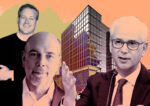Trending
Greening the city means getting realistic
Cities and companies need to be more systematic about green building, said the speakers at this afternoon’s Women’s Network for a Sustainable Future panel on green building and its costs and benefits for business.
“We can’t promote sustainable design without city planning,” Daniel Kaplan, senior partner at FXFowle Architects, said at the luncheon held at 125 Park Avenue.
In 30 or 40 years, he said, New York City will have grown by a million people, and “we will have to embrace the realities of urban architecture.”
Those realities include the fact that new development, even if it is green, can’t counteract the environmental damage done by older buildings constructed before energy efficiency became a priority. New building isn’t enough of a “substantial attack” on the problem of making buildings greener, said Adrienne Teleki, senior project manager in the development practice group at Jonathan Rose Companies.
In order to encourage the greening of real estate, Kaplan and Relina Bulchandani, director of the Internet business solutions group at Cisco, said governments need to incentivize green construction and office practices. The industry also needs a more rigorous way to measure buildings’ energy use, Kaplan said.
But while the commercial real estate market is already taking steps to go green, Kaplan said, the residential market isn’t focused on greening yet, tending to rely on traditional selling points instead. “It’s always puzzling to us that the residential market hasn’t caught up to this [green trend].”



